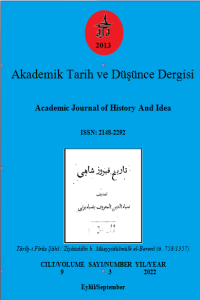Öz
Many discourses were expressed about the Karabakh conflict, which has been going on between the states of Armenia and Azerbaijan for about 32 years. However, most of these discourses approach the events from a political point of view. Undoubtedly women are among those most affected by the Karabakh war. Therefore, the main goal is to understand Karabakh from the eyes of women who lived in the war that happened between 1988-1994 and in September and November 2020 and reveal the belief in the solution to the Karabakh problem. Almost all the women who experienced the war in the region before the Karabakh War, particularly until the start of the 1988 conflicts, stated that they had very well neighboring relations with the Armenians. However, after the Khojaly and Kalbajar massacres, they indicated that it would not even be possible for the Azerbaijani people to live with the Armenian public again. As a result, the people of Azerbaijan are shouting to the whole world; “We, as Azerbaijanis, have never looked at the language, religion, and skin color of the people and therefore did not think that Armenia would invade our lands. But once again, we were wrong.” There is a prevailing opinion that the trust of the Azerbaijani people in Armenia is exhausted, and it will never be possible to live with them. In particular, the women interviewed after the 44-day war showed harsh responses and refused the probability of the questions related to living together again.
Anahtar Kelimeler
Kaynakça
- Referans1 ABDULLAHZADE Cavid, “Dağlık Karabağ Sorununda Ermenistan’ın Rolü Ve Sorumluluğu”, Ankara Üni. Hukuk Fak. Dergisi, 69 (4) 2020: 1541-1568.
- Refereans2 MUSTAFAYEV, Beşir, “Karabağ’ın İşgal Süreci ve Bölgede Yaşanan Son Olaylar Çerçevesinde Çözüm Arayışları,” Atatürk Üniversitesi, Türkiyat Araştırmaları Enstitüsü Dergisi, [TAED] 49, ERZURUM 2013, 281-294.
- Referans3 ŞIHALİYEV, Emin, “Ermenistan-Azerbaycan Çatışmasının Yakın Geleceği: Barış mı? Savaş mı? Yoksa Ateşkes mi?”, Ermeni Araştırmaları, 2013, Sayı 45, 73-92. YUNUSOV, Arif, “Karabakh: Past and Present, Bakü, 2005.
- Referans4 Letter dated 23 April 2002 from the Permanent Mission of Azerbaijan to the United Nations Office at Geneva addressed to the Chairperson of the Commission on Human Rights. https://digitallibrary.un.org/record/460440 (Accessed: 29 April 2021).
Öz
Many discourses were expressed about the Karabakh conflict, which has been going on between the states of Armenia and Azerbaijan for about 32 years. However, most of these discourses approach the events from a political point of view. Undoubtedly women are among those most affected by the Karabakh war. Therefore, the main goal is to understand Karabakh from the eyes of women who lived in the war that happened between 1988-1994 and in September and November 2020 and reveal the belief in the solution to the Karabakh problem. Almost all the women who experienced the war in the region before the Karabakh War, particularly until the start of the 1988 conflicts, stated that they had very well neighboring relations with the Armenians. However, after the Khojaly and Kalbajar massacres, they indicated that it would not even be possible for the Azerbaijani people to live with the Armenian public again. As a result, the people of Azerbaijan are shouting to the whole world; “We, as Azerbaijanis, have never looked at the language, religion, and skin color of the people and therefore did not think that Armenia would invade our lands. But once again, we were wrong.” There is a prevailing opinion that the trust of the Azerbaijani people in Armenia is exhausted, and it will never be possible to live with them. In particular, the women interviewed after the 44-day war showed harsh responses and refused the probability of the questions related to living together again.
Anahtar Kelimeler
Kaynakça
- Referans1 ABDULLAHZADE Cavid, “Dağlık Karabağ Sorununda Ermenistan’ın Rolü Ve Sorumluluğu”, Ankara Üni. Hukuk Fak. Dergisi, 69 (4) 2020: 1541-1568.
- Refereans2 MUSTAFAYEV, Beşir, “Karabağ’ın İşgal Süreci ve Bölgede Yaşanan Son Olaylar Çerçevesinde Çözüm Arayışları,” Atatürk Üniversitesi, Türkiyat Araştırmaları Enstitüsü Dergisi, [TAED] 49, ERZURUM 2013, 281-294.
- Referans3 ŞIHALİYEV, Emin, “Ermenistan-Azerbaycan Çatışmasının Yakın Geleceği: Barış mı? Savaş mı? Yoksa Ateşkes mi?”, Ermeni Araştırmaları, 2013, Sayı 45, 73-92. YUNUSOV, Arif, “Karabakh: Past and Present, Bakü, 2005.
- Referans4 Letter dated 23 April 2002 from the Permanent Mission of Azerbaijan to the United Nations Office at Geneva addressed to the Chairperson of the Commission on Human Rights. https://digitallibrary.un.org/record/460440 (Accessed: 29 April 2021).
Ayrıntılar
| Birincil Dil | İngilizce |
|---|---|
| Bölüm | Makaleler |
| Yazarlar | |
| Erken Görünüm Tarihi | 4 Ekim 2022 |
| Yayımlanma Tarihi | 8 Ekim 2022 |
| Yayımlandığı Sayı | Yıl 2022 Cilt: 9 Sayı: 3 |
По всем вопросам приема статей и выпуска очередных номеров обращаться в редакцию соответствующего журнала


